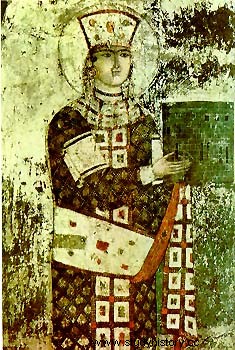Tamar (Georgian:თამარი), Thamar or Tamara (1160 – 1213) ruled Georgia for 29 years. Called “Tamar the King” at the time, she is considered the most famous of the country’s monarchs.
The influence of his aunt Rousoudan

Tamar is the eldest daughter of Bourdoukhan, daughter of the King of Ossetia, and George III, member of the Bagratid dynasty and King of Georgia. The princess and her sister Rousoudan received a privileged education, brought up in particular by Georges III's sister, Rousoudan. A diplomat, their aunt played a political role and participated in the management of a kingdom agitated at the time by revolts of nobles and quarrels over succession. Benefiting from the influence and teaching of her aunt, Tamar was quickly noted for her intelligence, and she was only twelve years old when her father announced that he would share the throne with her.
In 1179, George III kept his word and associated his daughter with the throne of Georgia, designating her as his heiress. Having no male heir, he then probably seeks to avoid the difficulties that his daughter will have to accede to the throne after his death. The Georgian nobles then swear loyalty to him. For five years, Tamar ruled the country alongside her father, until her father died in April 1184.
Sovereign of Georgia
Aged 24, the young woman is again crowned sovereign of Georgia. She is referred to by the title "king", being fully monarch herself and not the monarch's wife. The crowning of the first queen in Georgia's history raises eyebrows, and Tamar faces resistance. Despite the support of the influential Rusoudan, the young sovereign had to make important concessions to the nobility, including appointing the Catholicos-Patriarch of the Georgian Orthodox Church Michael IV Mirianisdze as Chancellor.
In 1185, it was under pressure from the nobility that Tamar married Yuri, son of Prince Andrew I Bogolioubski, to lead the country's army. If the man is a capable fighter, he is of a difficult character and marital relations turn to confrontation, while the young queen gradually conquers influence and independence. On the death of Michael IV Mirianisdze, she replaced him with one of her supporters; gradually, she replaces the nobles she had to appoint during her coronation with her own allies. In 1187, Tamar accused her husband of drunkenness and "sodomy" and convinced the nobility to approve his divorce. Sent back to Constantinople, Yuri attempted two coups, but failed each time.
An expansionist policy
Tamar herself chooses her second husband:David Soslan, prince of Ossetia with whom she will have two children. King consort, David becomes the first support of his wife and effectively leads the Georgian armies. His power consolidated, Tamar chose to resume the expansionist policy of his predecessors, in particular towards Azerbaijan, Turkestan, the Bagratid kingdom of Armenia. David wins many battles, and the kingdom of Georgia expands from the Black Sea to the Caspian Sea.
A fervent Christian, Tamar is eager to establish Christianity in the midst of neighboring Muslim countries; she seeks to position herself as the protector of Eastern Christians, particularly in the Holy Land. Thus, it supports churches and monastic communities in Jerusalem but also in Egypt, Bulgaria and Cyprus. After the conquest of Jerusalem by Saladin's army in 1187, Tamar obtained a right of passage to the holy city for Georgian pilgrims, unlike other Christian pilgrims. It promotes the installation of the Greek Orthodox Empire of Trebizond. In Georgia, Tamar devotes a tenth of the kingdom's income to the poor and establishes welfare institutions for them.
David died around 1207. After having, as his father had done with her, crowned his son George IV Lasha co-regent, Tamar died in turn in 1213. At the end of his reign, Georgia knew the age of of its prestige and influence in the Middle East. Enriched, the kingdom has expanded and counts vassals and allies among its neighbors, while trade and culture are flourishing. Tamar herself is considered the most illustrious ruler of Georgia. She was canonized by the Apostolic Orthodox Church of Georgia.
